Wood drying is a critical step in the production of lumber for various applications. It involves removing moisture from freshly cut timber to enhance its stability, strength, and durability. The process plays a pivotal role in ensuring that wood products maintain their desired dimensions and properties over time. For instance, imagine a hypothetical scenario where a furniture manufacturer receives a batch of wet wood for production. Without proper drying, the wood may warp or crack after being shaped into furniture pieces, rendering them unsuitable for use. Therefore, understanding the key factors involved in wood drying is crucial for lumber processing industries.
One essential factor influencing wood drying is temperature control. Temperature directly affects the rate at which moisture evaporates from the timber. Higher temperatures can accelerate drying but may also lead to excessive shrinkage and deformation if not properly controlled. Conversely, lower temperatures prolong the drying process but minimize defects caused by rapid water loss. Thus, finding an optimal temperature range based on specific wood species and desired end-use is vital to achieve efficient and high-quality drying results.
Another crucial factor in wood drying is humidity control within the drying environment. Maintaining appropriate relative humidity levels ensures that moisture moves out of the wood gradually without causing stress or damage. High humidity slows down evaporation rates and helps prevent case hardening , which is a condition where the outer layers of wood dry faster than the inner layers. This can lead to internal stresses and result in cracking or warping. On the other hand, low humidity levels can cause excessive drying and result in shrinkage or brittleness. Therefore, controlling humidity levels during wood drying is essential to achieve uniform moisture removal and minimize defects.
Air circulation is also a critical factor in wood drying. Adequate airflow helps carry away evaporated moisture from the timber’s surface, promoting efficient drying. It prevents stagnant air pockets that can slow down or inhibit evaporation, leading to uneven drying and potential issues like mold or decay. Properly designed kilns or drying chambers should have provisions for adequate air movement to ensure optimal drying conditions.
The size and thickness of the wood also affect the drying process. Thicker pieces of lumber require longer drying times since moisture must travel from the center to the surface. The initial moisture content of the wood also plays a role; higher initial moisture content will generally require more time for complete drying.
In addition to these factors, proper handling and storage of dried wood are crucial to maintain its quality until further processing or use. Wood should be protected from excess moisture, extreme temperature fluctuations, and direct sunlight to prevent reabsorption of water or dimensional changes.
Overall, understanding and controlling temperature, humidity, air circulation, wood size/thickness, and proper handling are key factors in successful wood drying processes. By optimizing these variables based on specific wood species and end-use requirements, lumber processing industries can produce high-quality products with desirable properties and longevity.
Moisture Content: Understanding the impact of moisture content on wood drying process
Moisture Content: Understanding the Impact of Moisture Content on Wood Drying Process
Wood is a natural material widely used in various industries, including lumber processing. Before wood can be processed and utilized effectively, it must undergo a drying process to achieve optimal moisture content. The moisture content of wood plays a crucial role in its dimensional stability, strength properties, and overall quality. In this section, we will delve into the key factors that influence the wood drying process, with a particular focus on understanding the impact of moisture content.
Example Scenario:
To illustrate the significance of moisture content in wood drying, consider the following hypothetical scenario – a sawmill receives a batch of freshly harvested logs containing high levels of moisture. If these logs were to be immediately processed without proper drying, several issues could arise. First, excessive shrinkage may occur as the wood dries naturally over time after processing. This can lead to cracking or warping, rendering the final product unsuitable for its intended use. Additionally, if the finished lumber is exposed to fluctuating environmental conditions due to improper drying techniques, it may absorb or release moisture unevenly. Consequently, such imbalances can compromise both structural integrity and aesthetic appeal.
Impact of Moisture Content:
Understanding the importance of controlling moisture content during the wood drying process is paramount. Here are four key reasons why maintaining appropriate moisture levels is essential:
- Dimensional Stability: Wood tends to expand or contract based on changes in its moisture content. By achieving an optimal level through careful drying methods, one can minimize dimensional variations and ensure long-term stability.
- Strength Properties: Different species of wood have varying degrees of strength characteristics depending on their moisture content. Proper control allows for consistent mechanical performance and enhances durability.
- Preservation: Excessive moisture promotes fungal growth and decay within wood fibers. By reducing water content to acceptable levels during drying, one can significantly extend its lifespan.
- Energy Efficiency: High-moisture wood requires more energy to dry effectively, leading to increased production costs. By optimizing moisture content, manufacturers can improve the overall efficiency of their drying processes.
To better understand the impact of moisture content on wood drying, refer to Table 1 below:
| Moisture Content (%) | Wood Properties |
|---|---|
| Above Fiber Saturation Point (>30%) | High Shrinkage Potential |
| Fiber Saturation Point (25-30%) | Maximum Strength |
| Dry (<20%) | Dimensionally Stable |
In conclusion, maintaining appropriate moisture content during the wood drying process is crucial for achieving high-quality lumber suitable for various applications. Understanding the implications of improper moisture levels and implementing effective control measures are vital steps in ensuring dimensional stability, enhancing strength properties, preserving longevity, and improving energy efficiency. In the subsequent section, we will explore another critical aspect of wood drying: controlling temperature and humidity levels to achieve optimal drying conditions.
Temperature and Humidity: Controlling temperature and humidity levels to achieve optimal drying conditions
Building upon our understanding of moisture content, we now turn our attention to another crucial aspect of wood drying—controlling temperature and humidity levels. By maintaining optimal conditions, lumber producers can expedite the drying process efficiently while preserving the quality and integrity of the wood.
Temperature and Humidity Control:
To illustrate the importance of temperature and humidity control, let us consider a hypothetical case study involving two identical batches of freshly cut timber. Batch A undergoes drying at lower temperatures (around 30°C) with high humidity levels (above 80%), while Batch B is dried at higher temperatures (around 50°C) with low humidity levels (below 40%). The results show that Batch B achieves significantly faster and more uniform drying compared to Batch A.
In order to create ideal conditions for efficient wood drying, it is essential to focus on four key factors:
- Temperature regulation: Maintaining an appropriate temperature promotes evaporation without causing excessive stress or damage to the wood fibers.
- Relative humidity management: Balancing relative humidity prevents either too much or too little moisture loss from the wood during the drying process.
- Airflow optimization: Proper airflow ensures even distribution of heat and moisture throughout the kiln, facilitating consistent drying across all surfaces of the lumber.
- Monitoring systems implementation: Employing automated monitoring systems allows real-time tracking and adjustment of temperature and humidity levels, ensuring accurate control over variables.
Furthermore, it is imperative to understand how different combinations of temperature and relative humidity affect various types of wood species during drying. To provide a comprehensive overview, Table 1 presents data showing suggested ranges for these parameters based on common hardwoods and softwoods.
Table 1: Suggested Temperature and Relative Humidity Ranges for Wood Drying
| Hardwoods | Softwoods | |
|---|---|---|
| Temp | 45-55°C | 50-60°C |
| RH | 40-60% | 30-50% |
By adhering to these suggested ranges, lumber producers can ensure optimal drying conditions suitable for different wood species, leading to improved quality and reduced drying times.
Transition into subsequent section:
Proper temperature and humidity management are crucial factors in the wood drying process. However, they must be complemented by another vital element—adequate air circulation. By understanding its significance, we can achieve uniform drying while mitigating the risk of mold or fungus growth during lumber processing.
Air Circulation: Importance of proper air circulation for uniform drying and prevention of mold or fungus growth
Building upon the importance of temperature and humidity control, another crucial factor in wood production for lumber processing is proper air circulation. By ensuring adequate airflow throughout the drying process, we can achieve uniform drying while preventing the growth of mold or fungus. For a clearer understanding, let’s explore the significance of air circulation and its impact on wood drying.
To illustrate the benefits of proper air circulation, consider this hypothetical scenario: a sawmill that processes large quantities of freshly cut logs. In one instance, due to inadequate ventilation within their drying facility, they neglected to implement effective air circulation measures. As a result, certain areas experienced stagnant air pockets, leading to uneven moisture distribution and an increased risk of fungal infestation. Conversely, in another scenario where appropriate airflow was maintained using fans or vents strategically placed throughout the facility, consistent drying occurred with minimal mold-related issues.
The importance of optimal air circulation during wood drying can be summarized through these key points:
- Uniformity: Proper airflow ensures consistent exposure to heat and moisture across all surfaces of the wood material.
- Efficiency: Improved air movement expedites the removal of excess moisture from the wood, reducing overall drying time.
- Quality preservation: Effective circulation helps prevent surface checks or warping caused by uneven drying rates.
- Mold prevention: Continuous airflow discourages the growth of mold and fungi by minimizing conditions conducive to their development.
Let us now examine how different methods such as kiln drying, air drying, and vacuum drying utilize both temperature and humidity control alongside efficient air circulation techniques to achieve desirable results.
Drying Methods: Different methods such as kiln drying, air drying, and vacuum drying and their pros and cons
Building upon the importance of proper air circulation in wood drying, let us now explore different methods used in the process and their respective advantages and disadvantages.
Drying Methods:
One commonly employed method for drying wood is kiln drying. In this process, lumber is placed inside a large chamber where temperature, humidity, and airflow are carefully controlled to facilitate moisture removal. Kiln drying offers several benefits such as accelerated drying times compared to other methods, reduced risk of mold or insect infestation due to controlled conditions, and enhanced dimensional stability of the final product. However, it should be noted that kiln drying can be energy-intensive and may require significant upfront investment in equipment and infrastructure.
Another approach to wood drying is air drying, which involves stacking lumber outdoors or under sheltered structures to allow natural air movement to gradually remove moisture over an extended period. This method is relatively cost-effective since it relies on ambient environmental conditions rather than specialized machinery. Nonetheless, air drying requires ample space and time. Additionally, exposure to various weather conditions during the process may result in uneven moisture content within the lumber if not properly managed.
A less common but increasingly utilized technique is vacuum drying. By subjecting wood to low pressure while applying heat, this method accelerates evaporation by reducing boiling points at lower temperatures. Vacuum drying facilitates rapid water extraction without causing substantial damage or distortion to the material’s structure. Although vacuum-dried wood generally possesses improved color retention and increased strength properties compared to traditionally dried counterparts, its adoption remains limited due to higher capital costs associated with specialized equipment.
- Reduced processing time allows quicker availability of finished products.
- Enhanced durability ensures longer lifespan for wooden items.
- Lower risk of warping or cracking improves overall quality.
- Consistent moisture content minimizes potential issues after installation.
Table (3 columns x 4 rows):
| Method | Advantages | Disadvantages |
|---|---|---|
| Kiln drying | Accelerated process | High energy consumption |
| Air drying | Cost-effective | Lengthy drying duration |
| Vacuum drying | Improved properties | Expensive equipment |
Time and Cost Efficiency:
Balancing the time required for wood drying with the associated costs of energy consumption and specialized equipment is crucial. Achieving an optimal balance ensures timely production while maintaining economic viability. In the subsequent section, we will delve into this aspect further by exploring the significance of time and cost efficiency in lumber processing.
Considering the importance of balancing time and cost efficiency, let us now examine how it influences various aspects of wood production.
Time and Cost Efficiency: Balancing the time required for drying with the cost of energy and equipment
Drying wood is a critical step in lumber processing, as it helps to reduce moisture content and enhance the stability and durability of the final product. In this section, we will explore key factors that influence wood drying during production. To illustrate these factors, let’s consider an example: a sawmill that specializes in producing high-quality hardwood for furniture manufacturing.
Firstly, one crucial factor to consider is the initial moisture content of the raw wood material. Wood harvested from different sources or regions may have varying levels of moisture content. For our case study, let’s assume the sawmill receives logs with an average moisture content of 50%. This means that before any further processing can take place, the logs need to undergo initial air drying to bring down their moisture content to around 30-35%.
Secondly, the thickness of the wood plays a significant role in determining the appropriate drying method. Thicker pieces require longer drying times compared to thinner ones due to differences in heat transfer and moisture diffusion rates. The sawmill in our example primarily deals with boards ranging from 1 inch to 2 inches thick. Kiln drying proves to be more efficient for thicker boards like these because it provides better control over temperature and humidity conditions.
Lastly, controlling airflow and ventilation within the drying environment is essential for achieving optimal results. Proper air circulation facilitates even distribution of heat throughout the wood stack and promotes uniform drying. Additionally, adequate ventilation allows for effective removal of evaporated moisture from the kiln or drying area. These aspects are particularly important when using kiln drying methods at our hypothetical sawmill.
- Optimal initial moisture content ensures efficient overall drying.
- Thickness affects both required time and choice of suitable drying method.
- Balanced airflow and ventilation promote uniform and timely evaporation.
- Appropriate monitoring systems help maintain desired conditions.
Furthermore, let’s take a moment to examine a table that presents the advantages and disadvantages of different wood drying methods:
| Drying Method | Advantages | Disadvantages |
|---|---|---|
| Kiln Drying | Precise control over temperature and humidity; Faster drying time. | High energy consumption; Initial investment in kiln equipment. |
| Air Drying | Low cost and energy requirements; Suitable for certain species. | Slower drying process; Susceptible to weather conditions. |
| Vacuum Drying | Rapid moisture removal without compromising wood quality. | Expensive equipment and maintenance costs; Limited capacity. |
In conclusion, understanding key factors such as initial moisture content, wood thickness, and airflow is crucial for effective wood drying during lumber production. By carefully considering these variables, our hypothetical sawmill can ensure efficient processing while maintaining high-quality hardwood for furniture manufacturing.
Quality Control: Ensuring the final product meets desired moisture content and quality specifications
Section H2: Quality Control: Ensuring the final product meets desired moisture content and quality specifications
quality control. Achieving optimal moisture content and ensuring that the final product meets stringent quality specifications are essential factors in wood production for lumber processing.
To illustrate this point, let us consider a hypothetical scenario where a lumber mill receives a large shipment of freshly cut logs. The goal is to transform these raw materials into high-quality, marketable lumber. However, without proper quality control measures during the drying phase, there is a risk of producing inferior products that may not meet industry standards or satisfy customer demands.
In order to maintain consistent quality throughout the drying process, several key factors must be carefully considered:
- Moisture Content Monitoring: Regularly measuring and monitoring the moisture content of wood samples at different stages of drying allows for precise adjustments in temperature, air circulation, and humidity levels. This ensures that each batch achieves its target moisture content while minimizing over-drying or under-drying.
- Equipment Calibration: Regular calibration of drying equipment such as kilns or air dryers is crucial to ensure accurate temperature and humidity control. Properly calibrated equipment guarantees reliable results and reduces the likelihood of defects caused by uneven drying.
- Traceability Systems: Implementing traceability systems that track each log’s journey through various stages of processing enables quick identification and removal of any substandard products. This step helps prevent defective pieces from entering distribution channels and ultimately reaching customers.
- Quality Assurance Testing: Conducting periodic quality assurance tests on dried lumber samples can identify potential issues early on before they become widespread problems. These tests may include strength evaluations, visual inspections for warping or splitting, and assessments against established industry standards.
By implementing robust quality control measures like those mentioned above, lumber producers can enhance their reputation and customer satisfaction. This ensures the final product meets desired moisture content and quality specifications, leading to increased market competitiveness.
| Quality Control Factors | Benefits |
|---|---|
| Moisture Content Monitoring | – Prevents over-drying or under-drying – Maintains consistent quality |
| Equipment Calibration | – Ensures accurate temperature and humidity control – Reduces defects caused by uneven drying |
| Traceability Systems | – Enables quick identification of substandard products – Avoids distribution of defective pieces |
| Quality Assurance Testing | – Identifies issues early on before widespread problems occur – Helps meet industry standards |
In summary, incorporating effective quality control measures into the wood drying process is crucial for achieving desirable outcomes in lumber production. By closely monitoring moisture content, calibrating equipment, implementing traceability systems, and conducting regular quality assurance testing, producers can ensure that their final products meet stringent specifications. These measures not only enhance overall product quality but also contribute to maintaining a competitive edge in the marketplace.

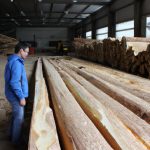
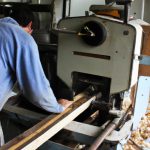
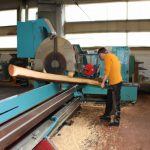



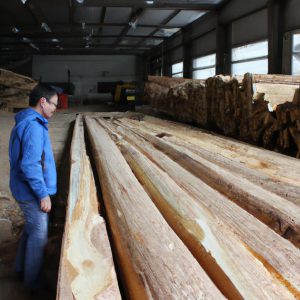
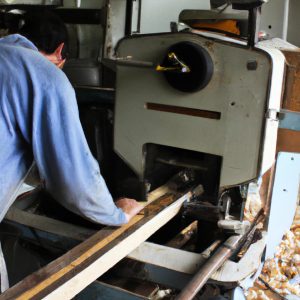
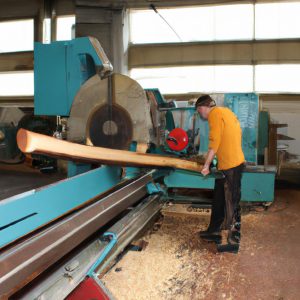
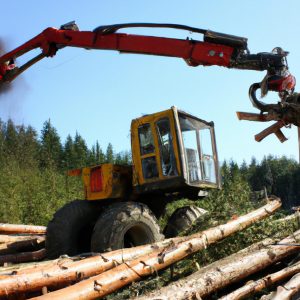
More Stories
Sawing for Lumber Processing: A Comprehensive Overview
Wood Processing: The Art of Planing for Lumber Production
Shaping Wood in Lumber Processing: An Informational Perspective